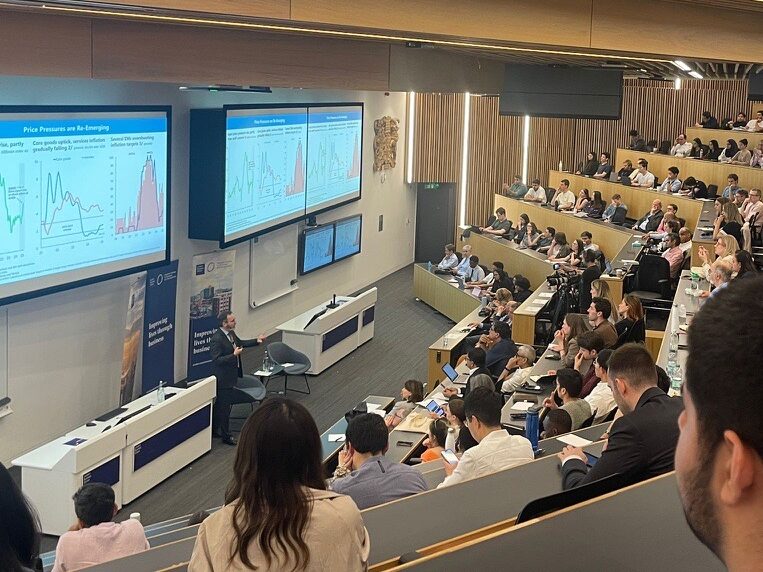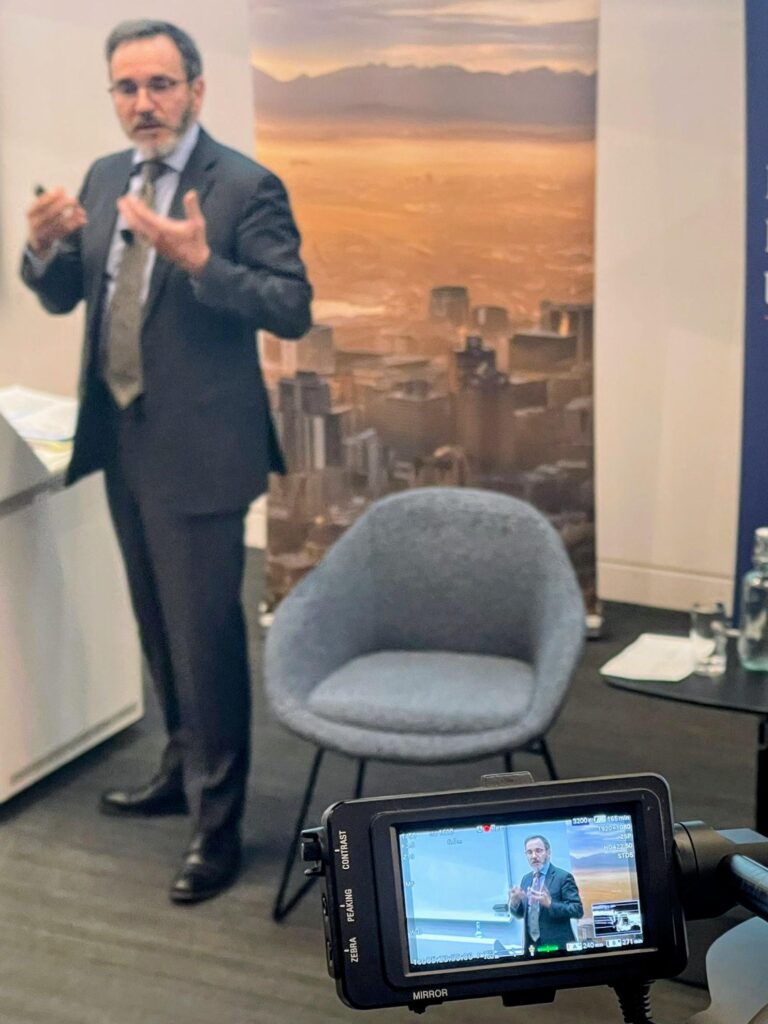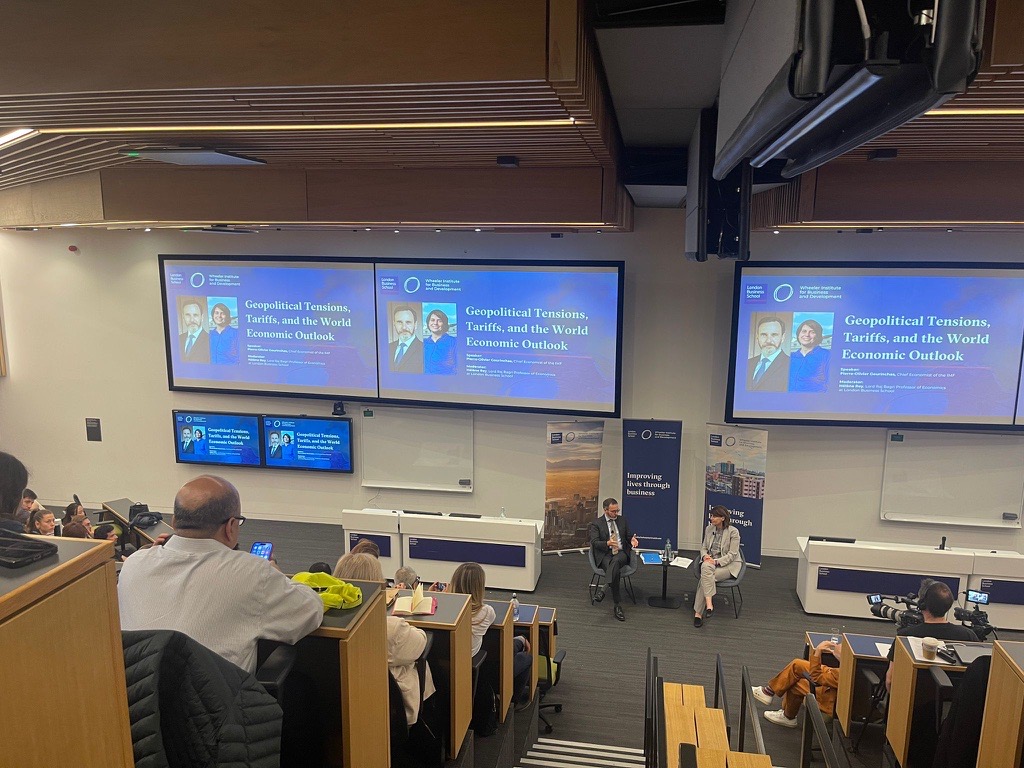The Wheeler Institute for Business and Development at London Business School hosted Pierre-Olivier Gourinchas, Chief Economist of the International Monetary Fund (IMF), for a timely and insightful discussion on the shifting global economic landscape. In a world increasingly shaped by trade tensions, geopolitical realignments, and inflation uncertainty, Gourinchas offered an comprehensive overview on global risks and the policy required to navigate them. The event was opened by Professor Sergei Guriev, Dean of London Business School, and moderated by Professor Hélène Rey, Lord Raj Bagri Professor of Economics at LBS.

A Global System Under Reset
Gourinchas began by outlining the extraordinary global context—marked by sweeping new trade policy announcements from the United States and shifting geopolitical dynamic, forcing policymakers to repeatedly adjust their outlooks and responses. This volatility, he argued, points to deeper structural changes: the post-World War II global economic order, long sustained by multilateral cooperation and institutions like the IMF, is now undergoing a profound transformation.
The rise of tariffs, intensifying geopolitical tensions, and growing economic nationalism are not isolated shocks, but the culmination of pressures that have been mounting for decades. These developments may signal the end of expanding trade openness and deepening multilateralism.



Rising Tariffs and the New Trade Landscape
Uncertainty dominates the current global outlook, driven by heightened geopolitical tensions and escalating trade policy shifts. These uncertainty shocks have reached historic highs, slowing down industrial production and dampening global growth.
A key concern is the growing use of tariffs. The U.S. has introduced sweeping new tariffs—particularly on China—raising effective rates to levels unseen since the early 20th century. Despite partial rollbacks followed the April 11 announcements, U.S. tariff levels remain high and have prompted reciprocal responses, increasing the global tariff burden.
One notable impact is front-loaded spending: firms accelerated imports in anticipation of rising tariffs, especially in early 2025, leading to a temporary surge in U.S. imports. This pattern reflects earlier trade conflicts, such as the 2018–2019 U.S.–China tariff war, when consumer spending spiked before declining post-imposition. Gourinchas noted these dynamics are already visible in recent data, further clouding the global economic outlook.

Resurfacing Inflation Pressures
Inflation, Gourinchas explained, is re-emerging as a key concern. While the inflationary surge from the COVID-19 pandemic and geopolitics tensions has largely subsided, the new round of trade restrictions is introducing fresh price pressures—particularly through higher input costs for manufacturing.
In advanced economies like the U.S., price increases are already being reported by manufacturers. Across G20 economies, while inflation in services still remains above target, inflation in goods, which had previously helped pull overall price levels down, is once again rising. Emerging markets are also feeling the heat. Countries such as Brazil and Mexico, which had made progress in bringing inflation under control, are now witnessing renewed upward pressures, with a growing number overshooting their central bank targets.
Another risk is the de-anchoring of inflation expectations, meaning long-term inflation expectations are no longer stable, unlike past inflation surges. Households, businesses, and workers might anticipate higher prices and wages and react quicker to the price increase, complicating central banks’ efforts to maintain inflation targets.
Diverging Currency Movements
Gourinchas also highlighted an unexpected shift in global currency dynamics following recent trade shocks and heightened policy uncertainty. Traditionally, the U.S. dollar strengthens during periods of global risk as a safe haven. Yet in the months following the U.S. presidential inauguration, the dollar depreciated despite rising global volatility.
Between the 2024 November election and 2025 January inauguration, the dollar surged with optimism in U.S. economy and expectations of delay in Federal Reserve rate cuts. However, this narrative collapsed after the inauguration. Growth forecasts were revised downward, and uncertainty spiked. Despite conditions that typically support the dollar, it continued to weaken.
What made the episode even more unusual was the combination of falling equity prices and rising bond yields—behaviour more typical of stressed emerging markets. Gourinchas explained this reversal as a shift in portfolio preferences, with investors rethinking their exposure to dollar-denominated assets amid growing doubts over U.S. fiscal sustainability and policy credibility.
Labour Market Structural Transformation
Gourinchas noted that labour markets in advanced economies remain broadly healthy, though signs of cooling have emerged. Unemployment rates have ticked up slightly from historic lows, but not indicative of an imminent recession.
Most job growth continues to come from the services sector, with manufacturing contributing less. This shift underpins many current policy efforts aimed at supporting domestic manufacturing. However, Gourinchas clarified that the long-term decline in manufacturing employment is not a result of trade, but of structural transformation driven by productivity gains. For example, the share of manufacturing in employment has steadily declined in both the U.S. and Germany since the 1960s, unaffected by events like China’s WTO entry or U.S. NAFTA renegotiation. Manufacturing output itself has not declined—goods are simply cheaper to produce due to efficiency gains.
For policymakers, the challenge lies not in reversing such labour market structural trends, but in ensuring workers are supported through the transition and that growth is inclusive across sectors.
Global Outlook: Slower Growth, Uneven Inflation
Looking ahead, Gourinchas pointed out the difficulty of forecasting in an environment of rapidly shifting trade policies. At the end of March, the IMF revised its 2024 global GDP growth forecast slightly downward to 3.2%. Subsequent projections incorporating the April 2 tariff announcements (reciprocal tariffs applied globally) and the later “pause” scenario (a flat 10% tariff globally except for China) suggest further moderation to around 2.8%.
While this represents a meaningful slowdown, Gourinchas noted that the difference in global growth between scenarios is modest. Economic growth is projected to decline across both advanced and developing economies under tariffs as announced on April 2. The impact, however, is unevenly distributed: some economies will be hit harder than others, particularly those most exposed to trade. Inflation outcomes are more mixed: in some regions, tariffs push prices higher due to costlier imports; in others, reduced demand leads to disinflation or even deflation.
How Tariffs Transmit Shocks Across Economies
Gourinchas offered a nuanced breakdown of the channels through which tariffs affect the economic activity and inflation in both the U.S. and the rest of the world, as well as US dollar:
- Incidence Effect: Tariffs increase the cost of imported goods, acting as a negative supply shock in the US as tariff-imposing country, damaging economy output and increasing inflation; For trading partners, tariffs reduce demand for their exports, creating a negative demand shock that lowers both activity and price pressures. This dynamic leads to dollar appreciation, as the U.S. maintains higher interest rates relative to the rest of the world.
- Supply Chain Disruptions: Complex global supply chains amplify the tariffs shock. Tariffs will cause additional inflationary supply shocks for both the U.S. and its trade partners. The impact on the dollar from this channel is ambiguous, depending on broader inflation and trade dynamics.
- Uncertainty Effects: Elevated trade policy uncertainty discourages both household consumption and firm investment. This generalized negative demand shock affects all economies but can hit the U.S. more if it targets all trading partners. If the U.S. demand shock is greater, the dollar could depreciate.
- Safe Haven vs. Portfolio Reallocation: Traditional safe-haven behavior would boost the dollar during volatility. However, recent developments showed dollar depreciation, suggesting a shift in global investor confidence. Foreign investors appear to be reducing exposure to dollar assets, reallocating toward alternatives like other foreign currencies and bonds.
Current regional economic data align with the above analysis. In the U.S., tariffs are producing a negative supply shock, reducing output and increasing inflationary pressures, while in China the impact reflects a negative demand shock, weighing on economic activity and contributing to deflationary pressures.
Rebalancing Through Macroeconomic Policy, Not Tariffs
While tariffs are now used as tools for correcting bilateral trade imbalances, deeper imbalances lie in savings and investment mismatches. China’s account surplus, though just over 2% of GDP, is globally significant due to its economic size. The U.S. runs large fiscal deficits, driving external imbalances, while the EU holds excess savings but underinvests in public goods and productivity.
Rather than relying on tariffs, he argued for coordinated macroeconomic policy reforms: China should pivot towards boosting domestic consumption and reducing its overreliance on exports; the U.S. must address its large fiscal deficit to reduce its external imbalance; the EU could stimulate growth by investing in public R&D and infrastructure, absorbing excess savings, and supporting productivity. These reforms would boost global growth and reduce imbalances more effectively than tariffs.
Adapting Fiscal and Monetary Policy for a New Era
Gourinchas underscored the critical importance of rebuilding fiscal buffers in the wake of the pandemic, highlighting concerns that government revenues have not kept pace with rising public spending. As public debt levels remain elevated across many economies – alongside growing demands for spending on national defence, economic support, and green transitions – countries must be more vigilant with their fiscal capacity, which is crucial for maintaining resilience and agility in today’s uncertain environment.
On the monetary front, he noted a growing divergence in both inflation trends and inflation expectations across regions. This heterogeneity signals that a “one-size-fits-all” policy is no longer viable. Central banks must tailor their responses to local economic conditions, leading to more differentiated monetary policy and potentially the end of era of synchronized interest rate hikes.
Global Fragmentation and Financial Stability
Addressing a question from Professor Rey on global fragmentation, Gourinchas acknowledged the growing risk of a decoupled world economy. While trade volumes held up during the last trade war due to supply chain rerouting, the current landscape is different. The IMF now projects that global trade as a share of GDP—a key indicator of economic integration—will decline over the next five years, marking a shift from past recovery patterns.
On a more optimistic note, Gourinchas pointed to growing momentum behind regional integration efforts. He emphasized the untapped potential for deepening regional trade, which could help promote open and transparent trade rules and reduce uncertainty. He also highlighted the rise of alternative financial instruments, such as stablecoins and cryptocurrencies, which present both opportunities and challenges for financial stability and monetary policy transmission, particularly in emerging market economies.
As Gourinchas made clear, the global economy stands at a crossroads. Trade barriers, inflation uncertainty, and policy fragmentation pose real threats—but resilience requires coordinated policy, not protectionism. The path forward must balance realism with renewed commitment to open cooperation and institutional trust.
About the speakers

Pierre-Olivier Gourinchas is the Economic Counsellor and the Director of Research of the International Monetary Fund (IMF). He is on leave from the University of California at Berkeley where he is the S.K. and Angela Chan Professor of Global Management in the Department of Economics and at the Haas School of Business. Professor Gourinchas was the editor-in-chief of the IMF Economic Review from its creation in 2009 to 2016, the managing editor of the Journal of International Economics between 2017 and 2019, and a co-editor of the American Economic Review between 2019 and 2022. He is on-leave from the National Bureau of Economic Research where he was director of the International Finance and Macroeconomics program, a Research Fellow with the Center for Economic Policy Research CEPR (London) and a Fellow of the Econometric Society.

Hélène Rey is the Lord Bagri Professor of Economics at London Business School. Until 2007, she was at Princeton University, as Professor of Economics and International Affairs. Her research focuses on the determinants and consequences of external trade and financial imbalances, the theory and empirics of financial crises and the organization of the international monetary system. She was elected President of the European Economic Association in 2022. Professor Rey is an elected Fellow of the British Academy, of the Econometric Society, of the European Economic Association, of the American Academy of Arts and Sciences, a Foreign Honorary Member of the American Economic Association, a correspondant of the Académie des Sciences Morales et Politiques. She was made O.B.E for services to Economics.
About the writer

Luise Lin is an MBA 2026 candidate at London Business School and an Outreach and Communication Intern at the Wheeler Institute for Business and Development. Prior to joining London Business School, she worked at Boston Consulting Group as Consultant in Australia, where she advised clients across private and public sectors as well as social enterprises. Luise is passionate about leveraging managerial science, innovative business models, and financial solutions to drive scalable economic development impact in developing regions. She is particularly interested in the intersections of management, policy and social impact, exploring how private sector solutions can contribute to sustainable development.
